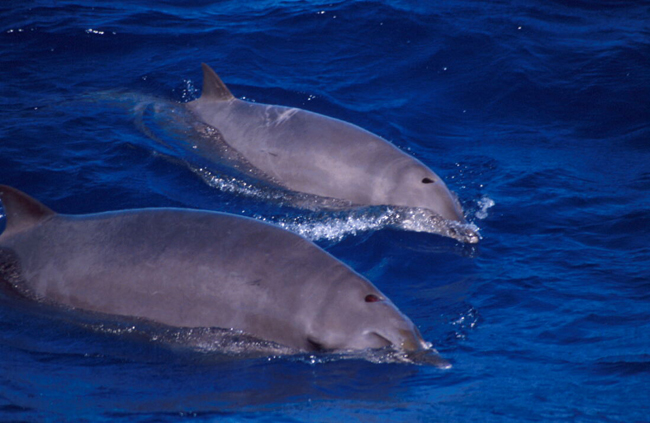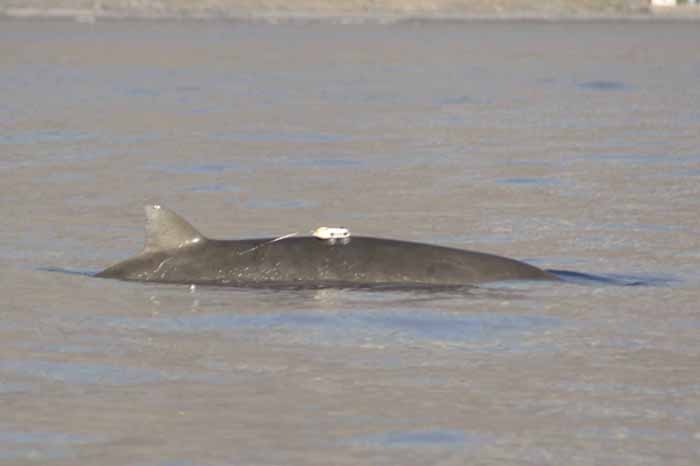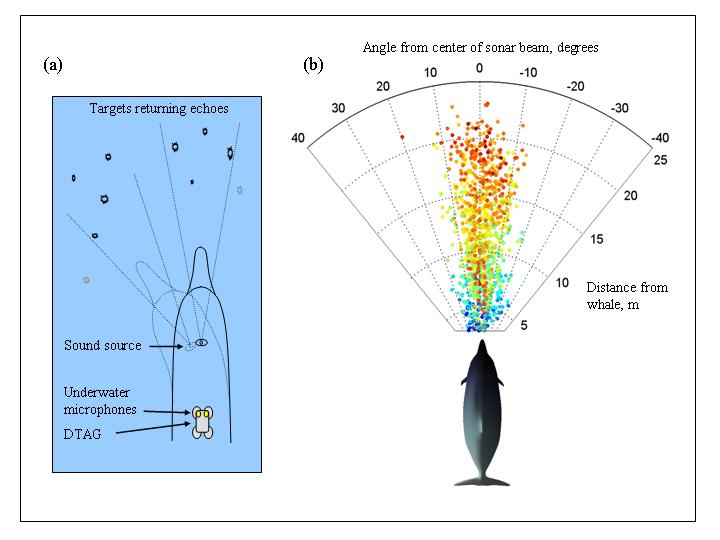ASA/CAA '05 Meeting, Vancouver, BC



Stereo Tag Reveals Deep Echolocation in Sonar-Sensitive Beaked Whales
Mark Johnson1- majohnson@whoi.edu
Peter Madsen1
Peter Tyack1
Natacha Aguilar de Soto2
1 Woods Hole Oceanographic Institution
Woods Hole, MA 02543
2 Dept. of Animal Biology, University of La Laguna, Canary Islands,
Spain
Popular version of paper 4aAB1
Presented Thursday morning, May 19, 2005
Joint ASA/CAA Meeting, Vancouver, BC
Beaked whales, a family of mid-sized odontocetes or toothed whales, are among the least known and most difficult to find of all whales. Nonetheless these deep-diving squid eaters have been the center of media and scientific attention recently due to an increasing number of mass strandings associated with the use of navy sonar with familiar incidents in Greece (1996), the Bahamas (2000), and the Canary Islands (2002 and 2004). Theories for the strandings abound, but without some basic understanding of the behavior of these reclusive animals it is impossible to know what might cause their fatal response to sonar or how to avoid this.
In an effort to learn more about beaked whales, the authors from Woods Hole Oceanographic teamed with researchers and naturalists in the Canary Islands (Spain) and Liguria (Italy). Both groups had discovered unusual resident populations of beaked whales in the deep submarine canyons and slopes near their coasts.
To study the whales, the Woods Hole team developed a miniature computer, called the DTAG, that records the sounds and movement of a whale while attached with suction cups. The tag records sound in stereo at almost 5 times the speed of a CD to catch the ultrasonic sounds made by whales and dolphins. When the 7 GByte memory in the tag is full, it detaches and floats to the surface where it is recovered using radio tracking. The team succeeded in tagging 10 beaked whales in 2003 and 2004; 7 Cuvier's beaked whales and 3 Blainvilles's beaked whales, two species common in the mass-strandings and the first time either specie had been tagged successfully.
The data immediately provided an unprecedented window into the behavior and
sounds made by these animals while searching for food in the dark depths. The
tag recorded dives almost 1.5 hours long and to depths of up to 1900 m by these
breath-hold diving champions, including the deepest dive recorded by a tag on
any mammal. It was found that both species make regular click sounds during
deep dives and, like dolphins and sperm whales, they find prey by echolocation.
What was new, however, was that echoes from objects in the water were actually
audible in the tag recording providing the first opportunity in any animal to
observe directly the process of prey selection and capture by echolocation.
With the stereo recording made by the DTAGs it was possible to measure the direction
from which each sound arrived. The tags were placed on the back of the whales,
behind the sound source in the head, so clicks from the tagged whales appeared
to come from in front of the tag but also wavered from side-to-side, revealing
that they turn their heads in a scanning motion while echolocating for prey.
Echoes from targets in the water always came from directions close to the direction
in which the head was pointing indicating that the whales make sound in a tight
beam. By scanning a narrow acoustic beam, like searching at night time with
a flashlight, the whales may be able to explore a large water volume while maximizing
the distance over which they can detect echoes.
These findings are not only interesting to biologists. Knowing what sounds
these whales make and how often, we may now be equipped to build listening devices
that can detect the animals from a distance. If such systems are practical,
they could be used to determine if beaked whales are in an area before navy
sonar is used, an important step towards reducing the mortality from mass strandings.
Funding from National Ocean Partnership Program, Strategic Environmental Research
and Development Program, U.S. Navy, Canarian Government

Fig. 1: Two Blainville's beaked whales swimming near the coast of El Hierro in the Canary Islands. Photo by Ivan Dominguez, ULL

Fig. 2: A suction cup attached DTAG hitch-hiking on a Blainville's beaked whale in the Canary Islands. Photo by M. Guerra/V. Gonzalez, ULL

Fig. 3: diagram of echolocation with some data
Sound Sample 1: Sound recorded by a DTAG on a Blainville's beaked whale echolocating at a depth of 700 m. Audible are a sequence of clicks leading into a buzz with impact sounds likely due to the whale catching a prey item. The wind-like noise is the sound of water flowing around the tag.
Sound Sample 2: An extract from the end of Sample 1 slowed down 6 times. At this rate, ultrasonic clicks from other nearby beaked whales as well as echoes from the sea floor are clearly audible.